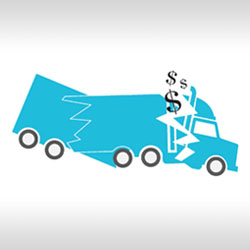Trucking Safety and the Bottom Line

Improving safety has many tangible and intangible benefits for a fleet, including decreased costs related to accidents, minimizing losses resulting from fines for safety violations, increased insurance premiums and damage to corporate reputation.
To improve truck safety, managers can take a multipronged approach that starts with spec'ing the right equipment for the job. It continues by ensuring drivers are operating the equipment correctly and fleet managers are properly maintaining the vehicle throughout its life cycle.
Calculating the Cost of Safety
The Centers for Disease Control and Prevention (CDC) reported that accidents related to trucks and buses cost the economy about $99 billion a year. According to a study conducted by the U.S. Department of Transportation (USDOT), the National Center for Statistics and Analysis (NCSA) and the National Highway Traffic Safety Administration (NHTSA), the average cost of a commercial truck accident is about $59,150. The Federal Motor Carrier Safety Administration (FMCSA) reported that costs from a single catastrophic crash can exceed $1 million.
The visible costs of an accident, such as damaged equipment and cargo, are the most obvious. Yet the true costs can run much deeper. "The cost of negative publicity surrounding a crash can be devastating to a company's bottom line and reputation," says Chuck Pagesy, director of safety for Penske Truck Leasing.
Start with Safety in Mind
Penske can work with you to understand your challenges and specify the safety devices to assist in meeting your safety needs, including passive cruise control, collision avoidance systems, rollover protection and disc brakes.
"These are all technologies the customers can opt into, and they provide opportunities to reduce their accident expense and any liability associated with it," Pagesy says. In addition, on-board safety technology continues to improve at a lower cost, which can increase Return on Investment (ROI).
Invest in Drivers
While advanced technology is one tool to help improve safety performance, it can't do it all. The driver is still in control of the vehicle and needs to be executing his or her responsibilities properly.
Penske offers driver training to all full-service lease and contract maintenance customers, with classes at customer locations, Penske Truck Leasing locations and online. Penske Truck Leasing also offers peer management seminars where groups of customers can join together with Penske to discuss emerging regulations and safety issues.
Visible Costs
- Cargo damage
- Vehicle damage
- Injury/medical expenses
- Loss of revenue
- Administrative costs
- Rising insurance premiums
- Towing and storage costs
- Loss of vehicle productivity
Hidden Costs
- Lost customers and sales
- Employee disability costs
- Cost to hire and train replacement workers
- Risk to reputation
- Public relations costs
- Legal expenses
Maintain Vehicles
Properly maintaining vehicles through rigorous preventative maintenance (PM) ensures performance, which directly relates to safety. "Every time we do a PM, all safety items are checked," says Mike Hasinec, vice president of maintenance support at Penske Truck Leasing. "Safety is just as important to us as it is to our customers."
Penske maintains vehicles at and above FMCSA regulations and provides fleet performance metrics to identify and assess risk. Penske also handles licensing and vehicle tax reporting to ensure fleets are compliant, and tracks all aspects of maintenance and repairs.
Safety is Serious Business
Penske takes safety seriously. Implementation of safety recommendations can help reduce costs related to crashes. It also can lead to lower insurance rates, fewer claims and improved reputation. That's why Penske offers important safety programs as part of our core services, with no additional cost to customers.
July 2016

